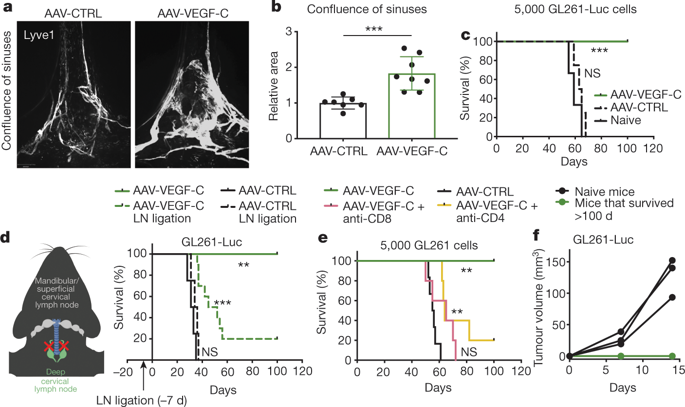Nature ( IF 64.8 ) Pub Date : 2020-01-15 , DOI: 10.1038/s41586-019-1912-x Eric Song 1 , Tianyang Mao 1 , Huiping Dong 1 , Ligia Simoes Braga Boisserand 2 , Salli Antila 3 , Marcus Bosenberg 1, 4, 5 , Kari Alitalo 3 , Jean-Leon Thomas 2, 6 , Akiko Iwasaki 1, 3, 7

|
Immune surveillance against pathogens and tumours in the central nervous system is thought to be limited owing to the lack of lymphatic drainage. However, the characterization of the meningeal lymphatic network has shed light on previously unappreciated ways that an immune response can be elicited to antigens that are expressed in the brain1,2,3. Despite progress in our understanding of the development and structure of the meningeal lymphatic system, the contribution of this network in evoking a protective antigen-specific immune response in the brain remains unclear. Here, using a mouse model of glioblastoma, we show that the meningeal lymphatic vasculature can be manipulated to mount better immune responses against brain tumours. The immunity that is mediated by CD8 T cells to the glioblastoma antigen is very limited when the tumour is confined to the central nervous system, resulting in uncontrolled tumour growth. However, ectopic expression of vascular endothelial growth factor C (VEGF-C) promotes enhanced priming of CD8 T cells in the draining deep cervical lymph nodes, migration of CD8 T cells into the tumour, rapid clearance of the glioblastoma and a long-lasting antitumour memory response. Furthermore, transfection of an mRNA construct that expresses VEGF-C works synergistically with checkpoint blockade therapy to eradicate existing glioblastoma. These results reveal the capacity of VEGF-C to promote immune surveillance of tumours, and suggest a new therapeutic approach to treat brain tumours.
中文翻译:

VEGF-C 驱动的淋巴引流可实现脑肿瘤的免疫监测
由于缺乏淋巴引流,对中枢神经系统病原体和肿瘤的免疫监测被认为是有限的。然而,脑膜淋巴网络的特征揭示了以前未被重视的方式,即可以对大脑中表达的抗原引发免疫反应1,2,3. 尽管我们对脑膜淋巴系统的发育和结构的理解取得了进展,但该网络在引起大脑中保护性抗原特异性免疫反应方面的贡献仍不清楚。在这里,使用胶质母细胞瘤的小鼠模型,我们表明可以操纵脑膜淋巴管系统以产生更好的针对脑肿瘤的免疫反应。当肿瘤局限于中枢神经系统时,CD8 T 细胞介导的对胶质母细胞瘤抗原的免疫非常有限,导致肿瘤生长不受控制。然而,血管内皮生长因子 C (VEGF-C) 的异位表达促进了引流颈深淋巴结中 CD8 T 细胞的增强启动,CD8 T 细胞迁移到肿瘤中,胶质母细胞瘤的快速清除和持久的抗肿瘤记忆反应。此外,表达 VEGF-C 的 mRNA 构建体的转染与检查点阻断疗法协同作用以根除现有的胶质母细胞瘤。这些结果揭示了 VEGF-C 促进肿瘤免疫监视的能力,并提出了一种治疗脑肿瘤的新治疗方法。



























 京公网安备 11010802027423号
京公网安备 11010802027423号